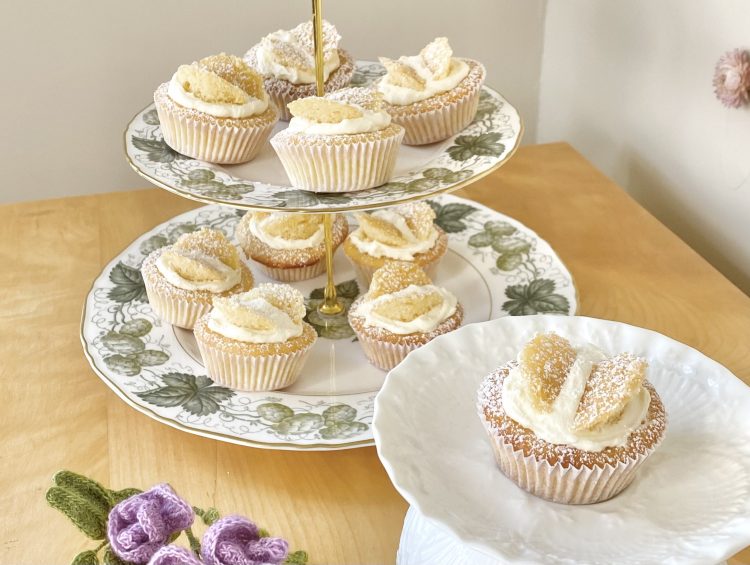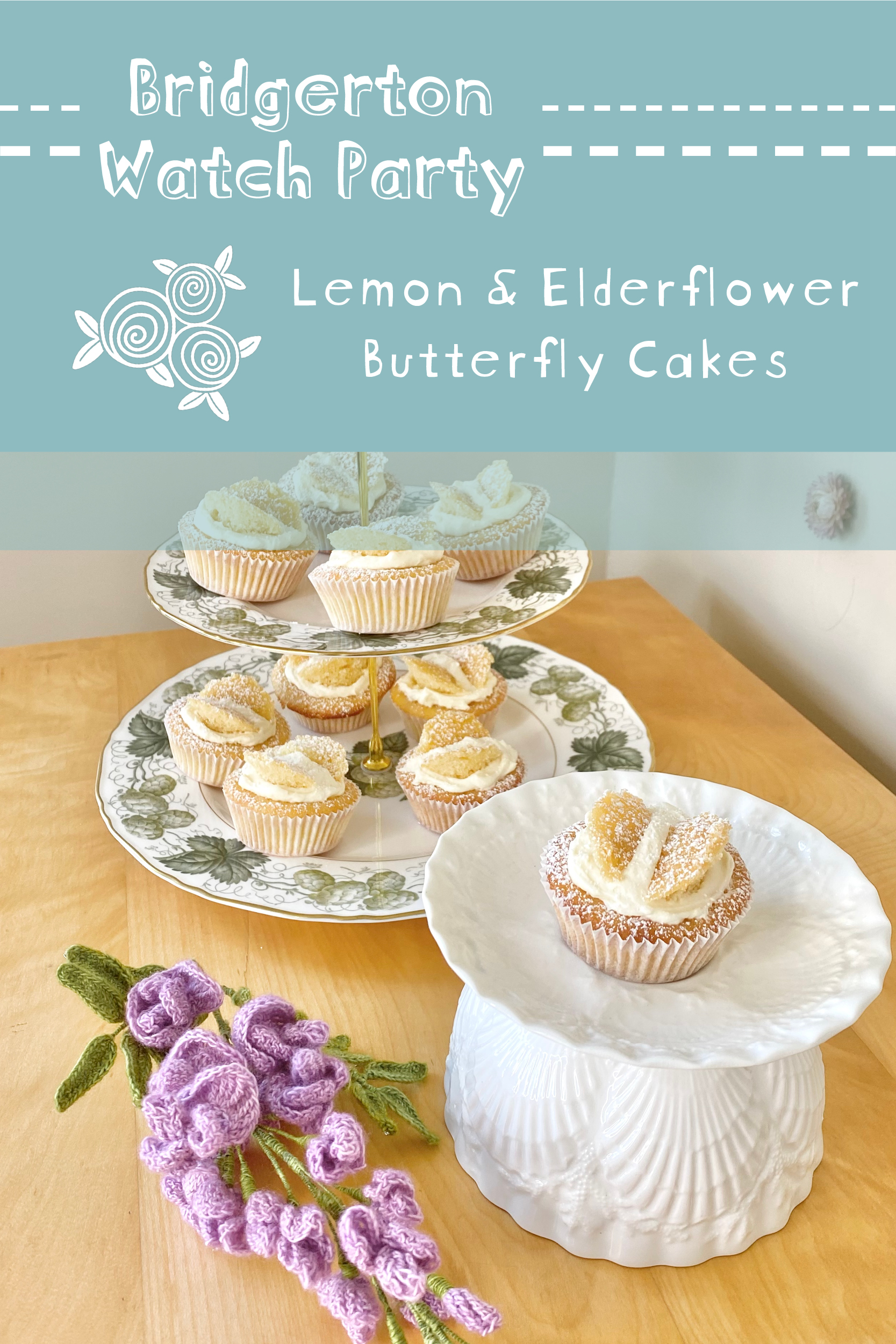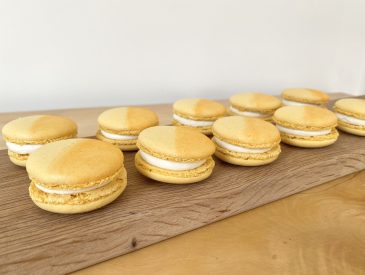Welcome to Bridgerton Watch Party Week! 7 days, 6 brand new, Bridgerton-inspired recipes & lots of tips, tricks and ideas for creating an afternoon tea-style dessert table worthy of the show. Whether you’re planning to host a Season 3 watch party yourself, or just want to make your own viewing experience extra sweet- I’ve got you covered!
Next up are these Lemon & Elderflower Butterfly Cakes. They’re fresh, zingy and my ode to Penelope Featherington, the female lead of Bridgerton Season 3!
Table of Contents
- Inspiration
- Ingredients
- Making the Lemon & Elderflower Curd
- Making the Lemon Fairy Cakes
- Making the Elderflower Ermine Buttercream
- Assembling the Butterfly Cakes
- Lemon & Elderflower Butterfly Cakes Recipe
Inspiration
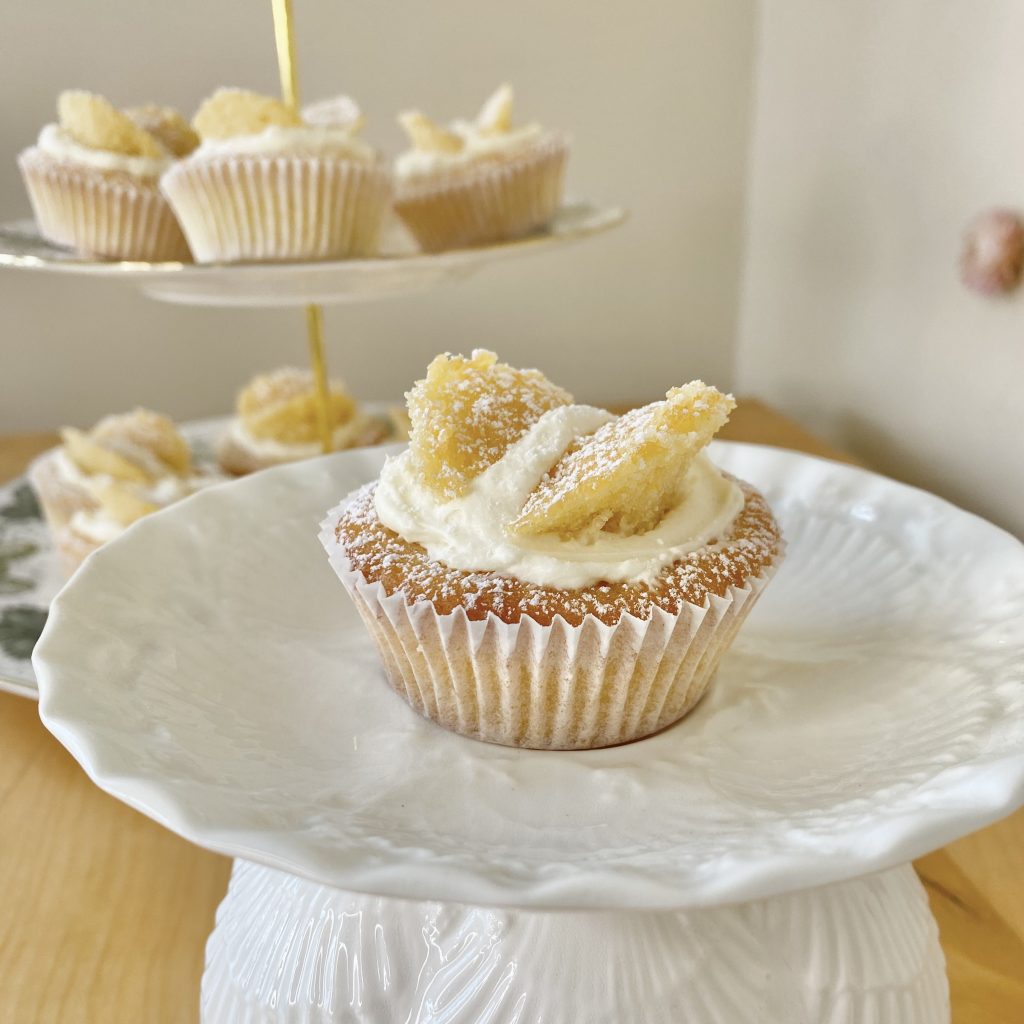
As I mentioned, this cake is inspired by the female lead of Bridgerton Season 3: Penelope Featherington. In the first two seasons, it’s a running joke that Penelope’s outfits are all very… yellow… so I thought lemon would be a fitting flavour for her cake. I wanted to make these cakes extra fancy, so I added some elderflower flavour too (with the help of elderflower cordial). Lemon and elderflower is a flavour combination that has become super popular in recent years (particularly after the 2018 Royal Wedding!), and it just tastes so light and fresh and sweet- exactly the right vibe for my Bridgerton Watch Party!
There are numerous motifs that run throughout the Bridgerton series and make their way into the costumes, hairstyles and settings. Penelope Featherington (indeed, the whole Featherington family) is typically paired with the motif of a butterfly, so it couldn’t not turn these lemon and elderflower cakes into butterfly cakes. Butterfly cakes are such a nostalgic treat to me- I’m not sure if they’re particularly common outside of the UK, but I grew up baking them. Essentially, a butterfly cake is just a fairy cake (not a cupcake- fairy cakes are kind of… squatter versions of cupcakes?), with the top cut off in a shallow cone shape. The cut-off piece of cake is then cut in half, down the middle, to make two ‘wings’. The hollow left in the cake is filled- usually with jam and cream, but it can be with anything (in this case, with a lemon and elderflower curd, along with an elderflower buttercream)- and the cake ‘wings’ are placed back on top at an angle, to make the cakes look like a little butterflies. It’s such an effective way of making a simple cake look super pretty!
Ingredients

For these Lemon & Elderflower Butterfly Cakes, you will need:
- Eggs
You need eggs for both the lemon cake batter and the lemon & elderflower curd. As always, I use large eggs.
- Lemons
For a lemon cake, you need lemons! You’ll need the zest and juice for both the curd and the cake batter.
- Caster sugar
You’ll need caster sugar for all three elements of these cakes, so it’s pretty important!
- Unsalted butter
You will need unsalted butter for both the curd and the buttercream. While I use Stork for my cake batters, I don’t recommend using it for curd/buttercream- stick to regular butter for these elements.
- Stork
As always, I like to use Stork for my cake batters, because I think it gives a lighter, fluffier cake. If you can’t find Stork, or would prefer not to use it, you can substitute it for an equal amount of softened, unsalted butter.
- Elderflower cordial
Elderflower cordial is a super easy, year-round way of getting elderflower flavour into baked goods. You’ll be adding this to both the curd and the buttercream to impart a lovely, floral flavour.
- Plain flour
Plain flour is used in the cake batter, but it is also an important ingredient in the ermine buttercream (I know it sounds weird, but trust me! It’s delicious).
- Baking powder
This helps the fairy cakes to rise, making them light and fluffy.
- Salt
Just a little pinch- to bring out all of the other flavours.
- Milk
Milk is used in both the cake batter and the buttercream to help achieve the right consistency for each one. While you absolutely can use skimmed milk in both elements (and I usually do because that’s what we typically have in the house!), using whole milk, particularly for the buttercream, will make it extra creamy and luxurious, so use that if you have it.
- Icing sugar
Just a small amount, for dusting over the finished butterfly cakes.
Making the Lemon & Elderflower Curd
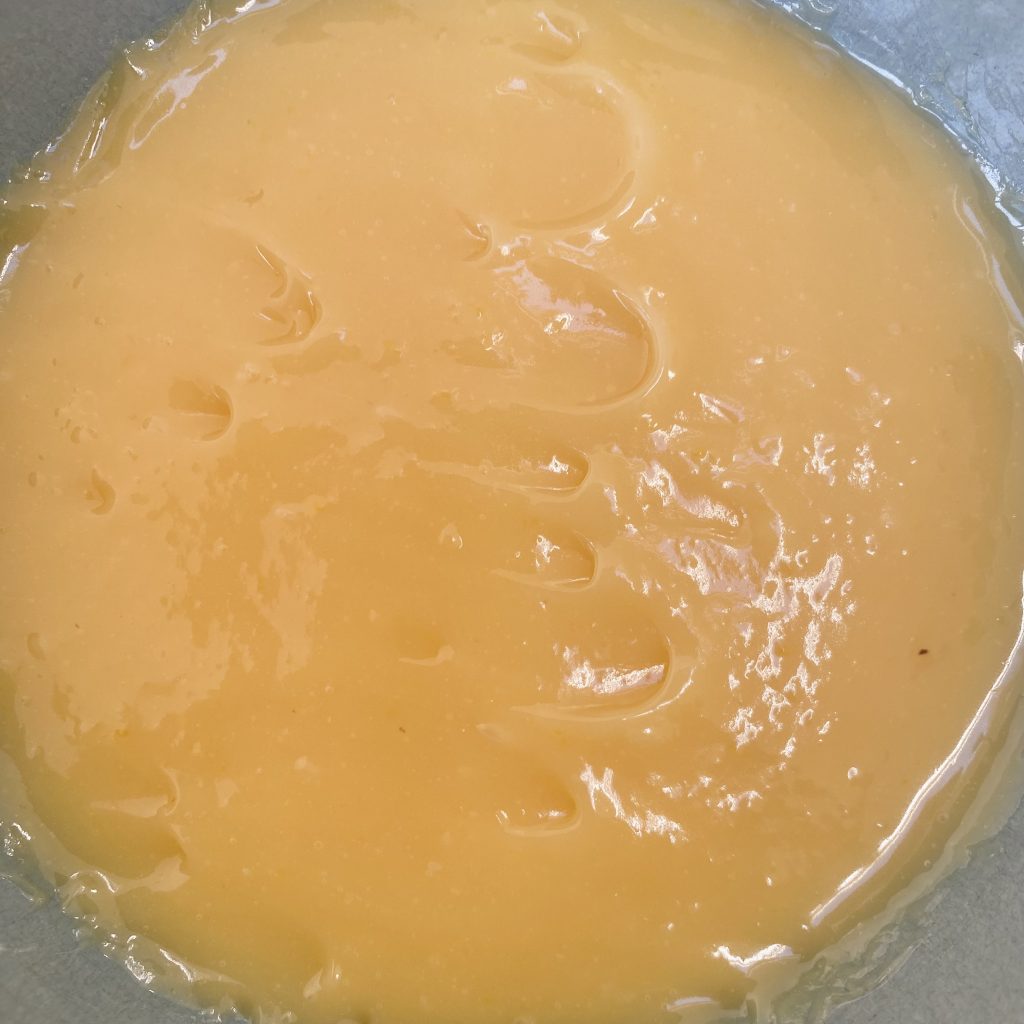
The lemon & elderflower curd needs time to chill in the fridge, so get that out of the way first, before you make the cupcakes. You can even make it a few days in advance, if you like, and store it in the fridge until you’re ready to use it. This recipe makes significantly more lemon curd than you will need to fill the fairy cakes, but, unless you fancy attempting to split an egg (which, admittedly, I have done in the past- so it’s not impossible if you’re desperate!), it’s for the best. In fact, the curd is delicious on toast, pancakes (the list goes on), so it won’t be wasted!
A quick confession before we start: I make curd in a bit of a sacrilegious way- I make the whole thing in a saucepan, straight over direct heat. I know you’re supposed to make it over a bain marie, so that you don’t scramble the eggs, but… I’ve never successfully made curd like that… I’ve just never been very good with double boilers. Sigh. Anyway, the point: if you’re used to making curd over a bain marie- do that! The quantities and everything will be exactly the same. In this post, however, I’ll be explaining how I make it in a saucepan.
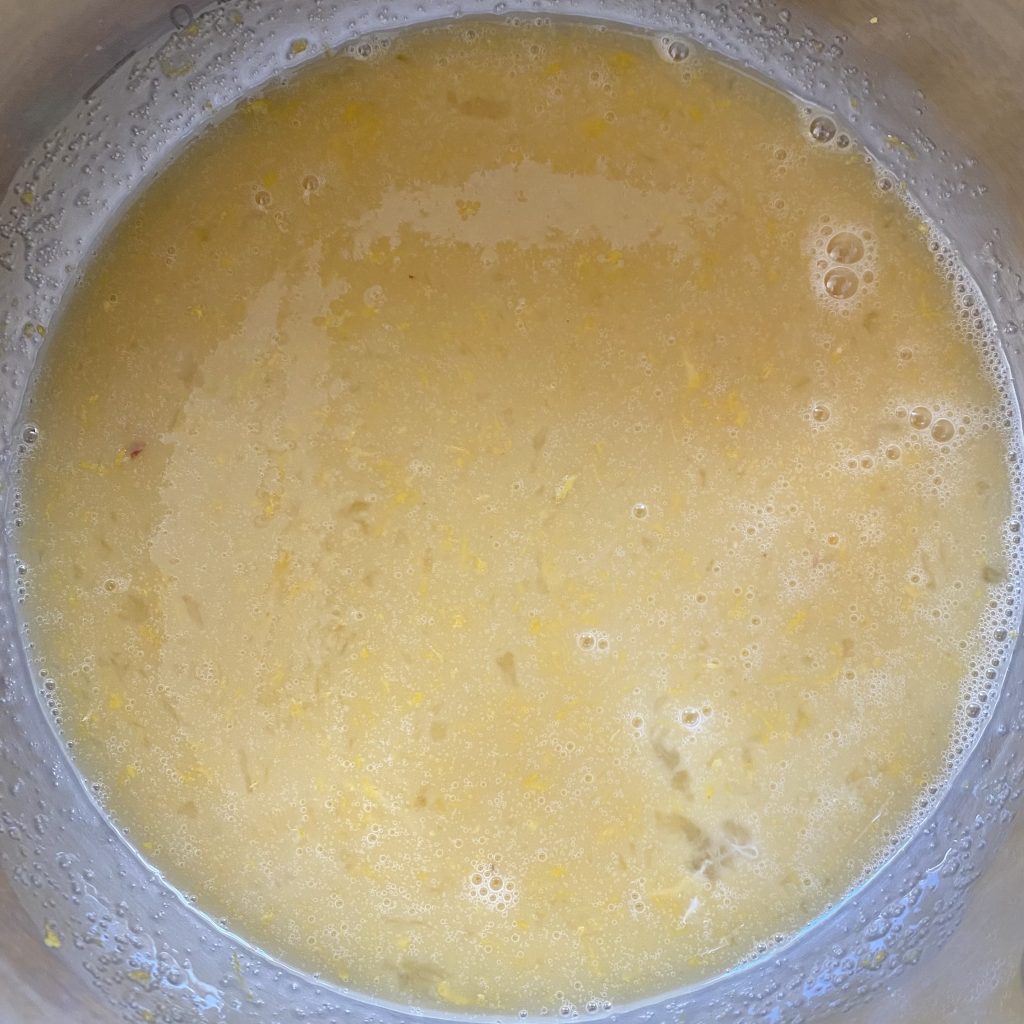
Start by whisking together the egg, caster sugar, lemon zest and juice in a small saucepan. By whisking these ingredients together really well at this stage, you reduce the possibility of there being any big pieces of egg that might scramble.
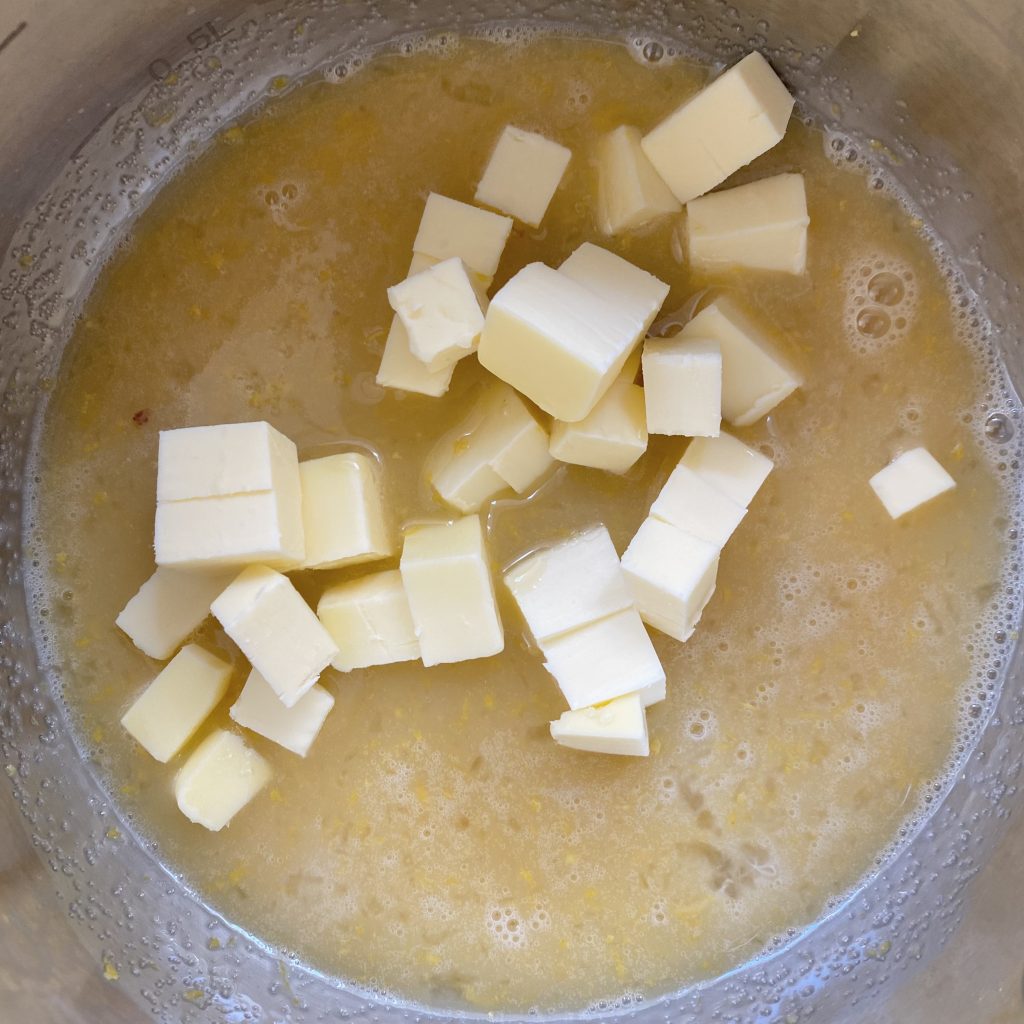
Then, add the diced butter. Dicing the butter helps it to melt more quickly and adding it to the pan afterwards just makes it easier to whisk the initial ingredients together.
Put the pan over a medium-low heat and stir constantly with a heatproof spatula as the butter melts. I prefer to use a spatula, because sometimes I get carried away with my stirring and make my curd frothy if I use a whisk, but you can use a whisk if you prefer.
When the butter has melted, keep the pan over the heat and keep stirring. After a few minutes, the curd will start to thicken. Keep stirring until it is nice and thick, then remove it from the heat.
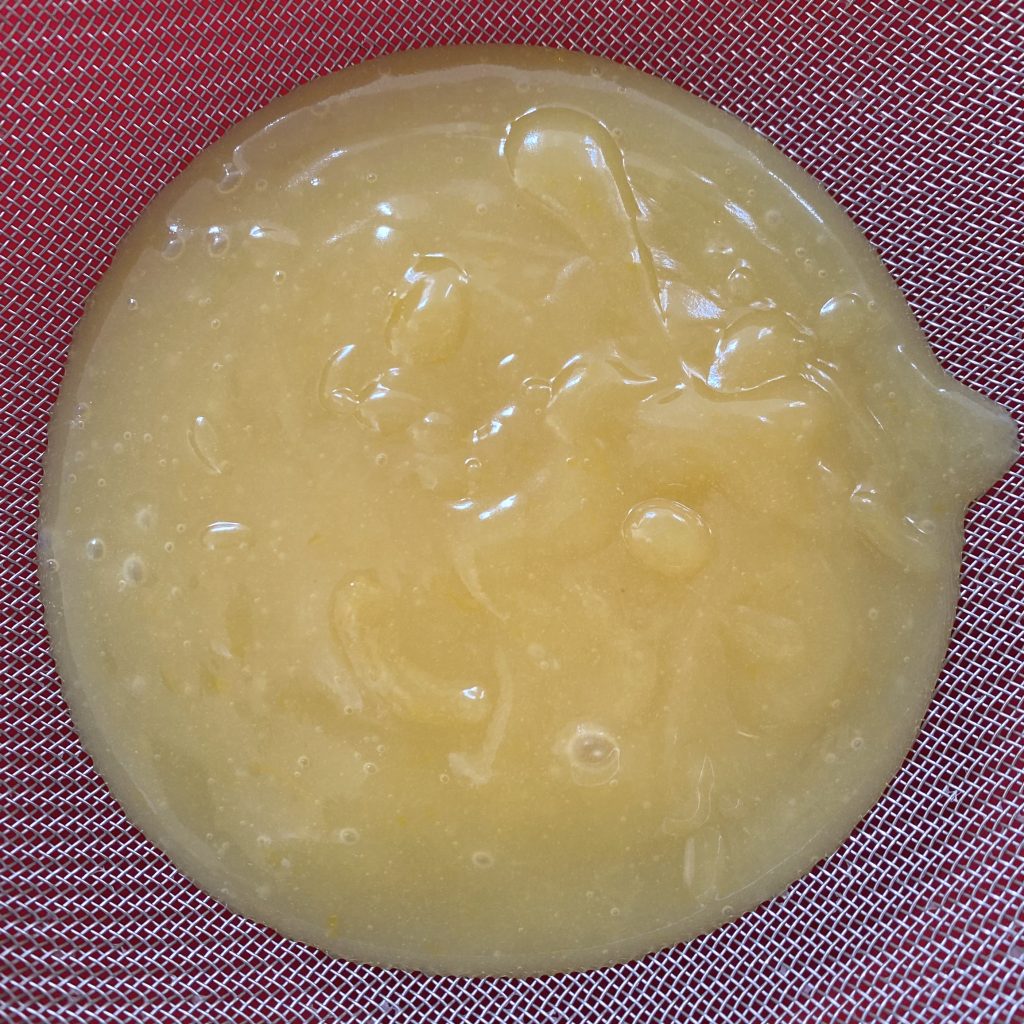
At this point, you want to push the curd through a fine, heatproof sieve into a small bowl, just to remove any pieces of egg that you might have missed. Honestly, I always do this, even when I attempt to make curd over a bain marie, so I don’t feel like it’s an extra faff or anything. I usually get a couple of pieces of egg left in the sieve, along with the zest (but that’s okay, because, by this point, the zest has already imparted all of its zestiness) and am left with a super smooth, super luscious (and, most importantly, super speedy) lemon curd.
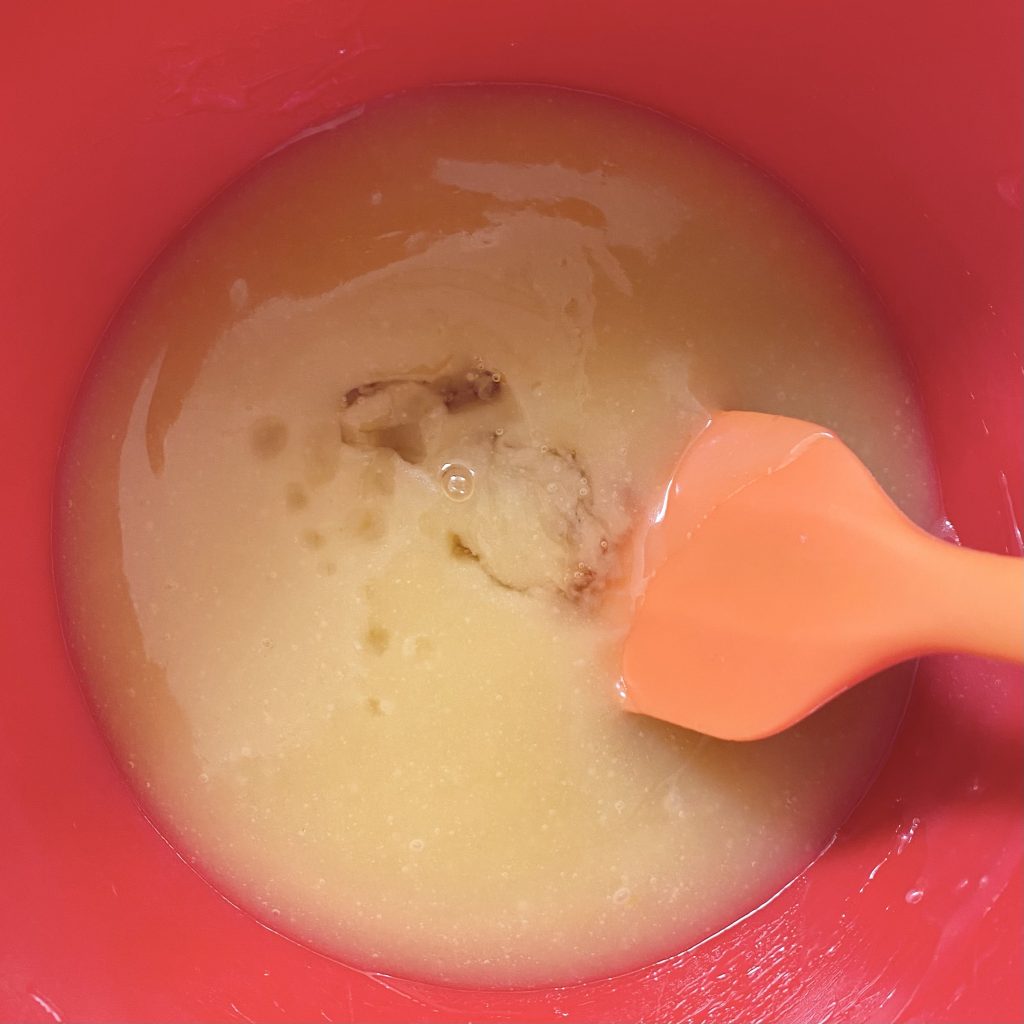
Once you have a silky-smooth curd, add the elderflower cordial and stir it through. By adding the cordial at this stage, after the cooking process, you preserve its fresh, zingy flavour.
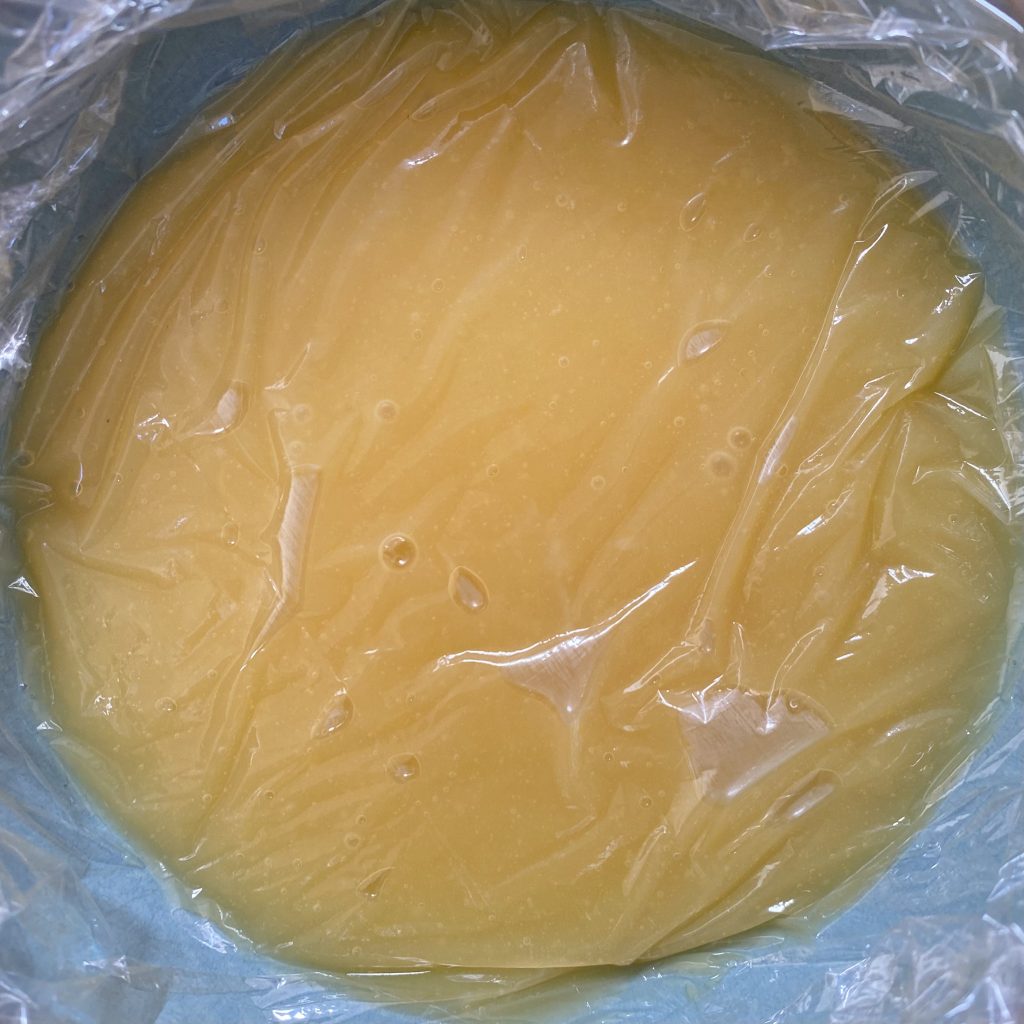
Cover with cling film, making sure to press it directly onto the surface of the curd, to prevent a skin from forming, then place it into the fridge for at least an hour, to chill and thicken up even more, before using.
Making the Lemon Fairy Cakes
For these cakes, I’ve used the reverse-creaming method. The reason for this is two-fold: firstly, this method gives a slightly more close-textured cake, which makes it easier to cut out the ‘wings’ from the cakes later. Secondly, the reverse-creaming method requires a higher proportion of liquid ingredients, which means you can add extra lemon juice to the cake batter and get a more intense lemon flavour in your cupcakes. It’s a win-win, right?
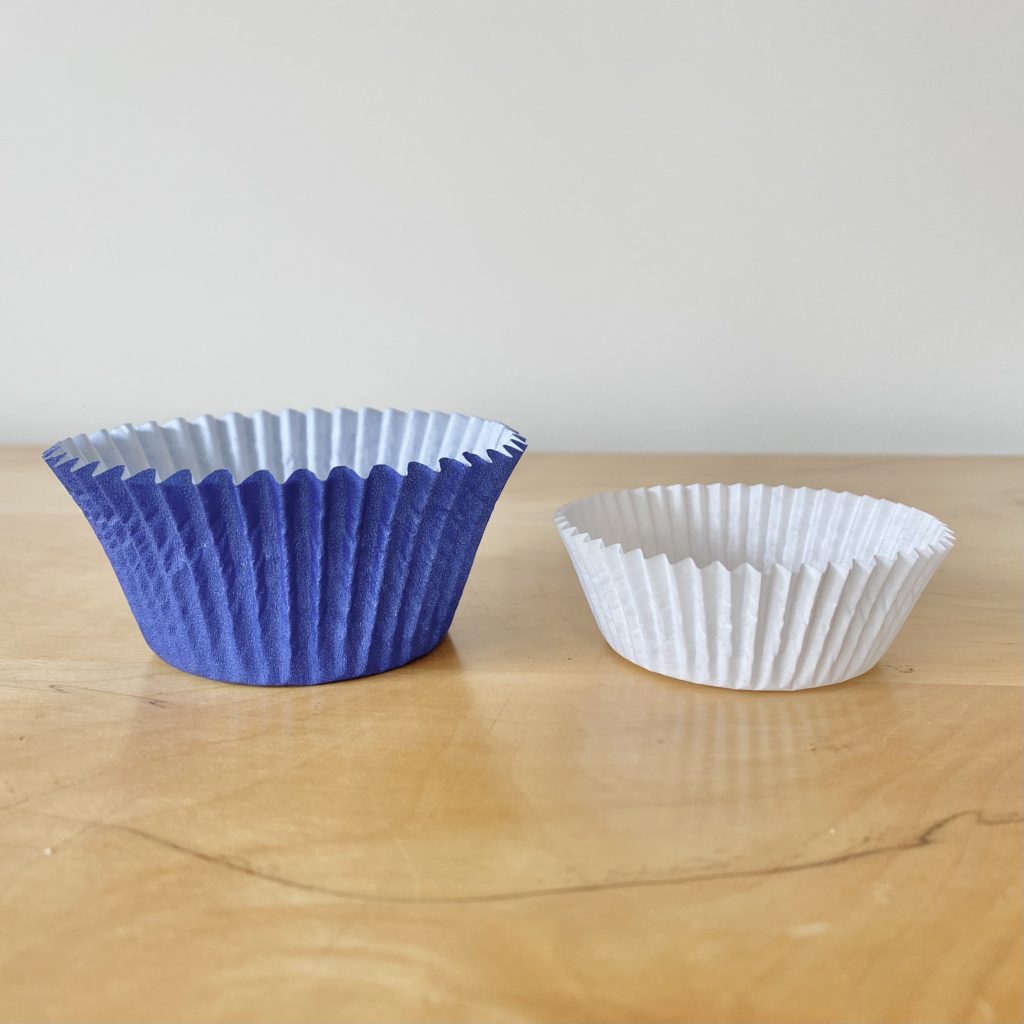
Start by preheating the oven to 180°C (conventional oven). Line a fairy cake tray with fairy cake cases and set aside. A quick note here: fairy cake cases are not the same as cupcake cases- in the photo above, the cupcake case is on the left, whereas the fairy cake case is on the right. As you can see, the cupcake case is significantly taller. You can find fairy cake cases in most supermarkets.
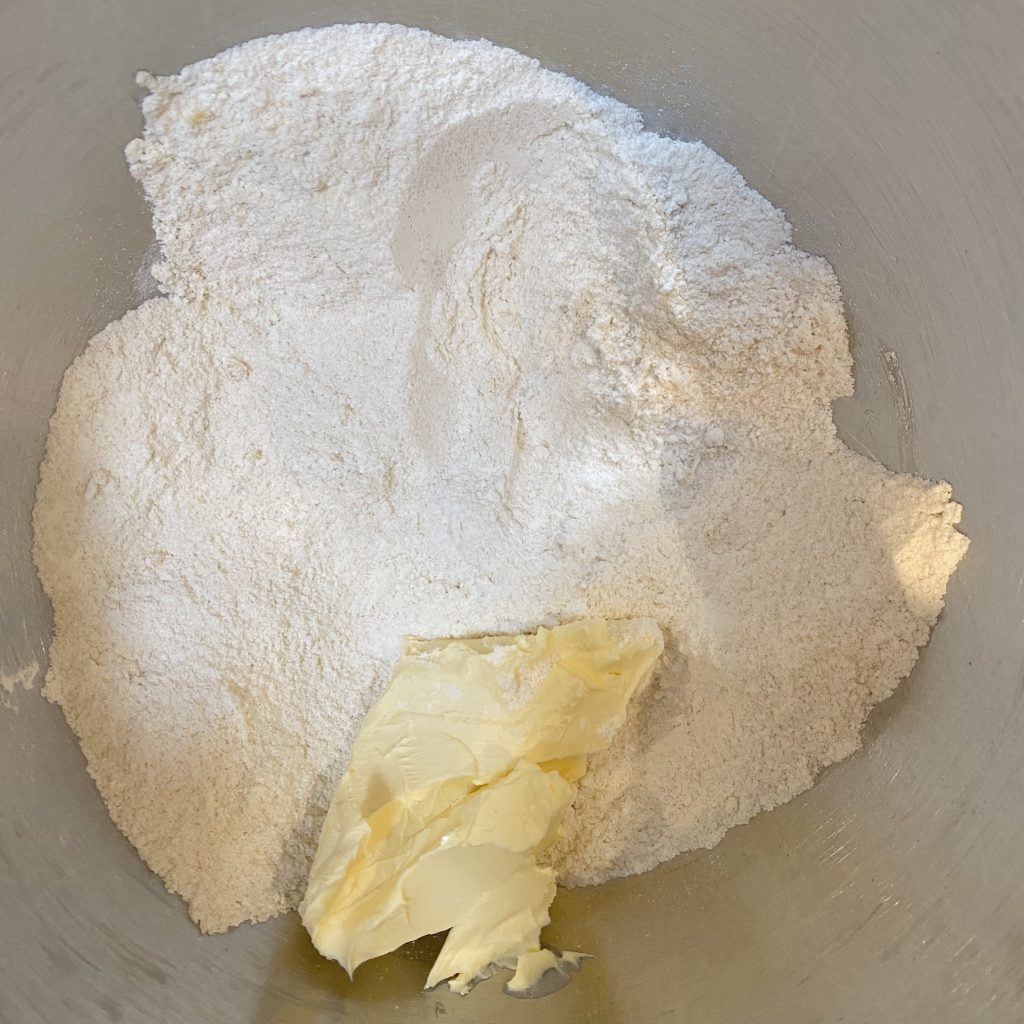
For the cake batter, place the flour, sugar, baking powder, salt and lemon zest into the bowl of a freestanding mixer, fitted with the paddle attachment. Mix on low speed briefly, just to combine all of the ingredients, then add the Stork (or softened unsalted butter, if you’re using that instead).

Mix on low-medium speed until the mixture resembles fine breadcrumbs.
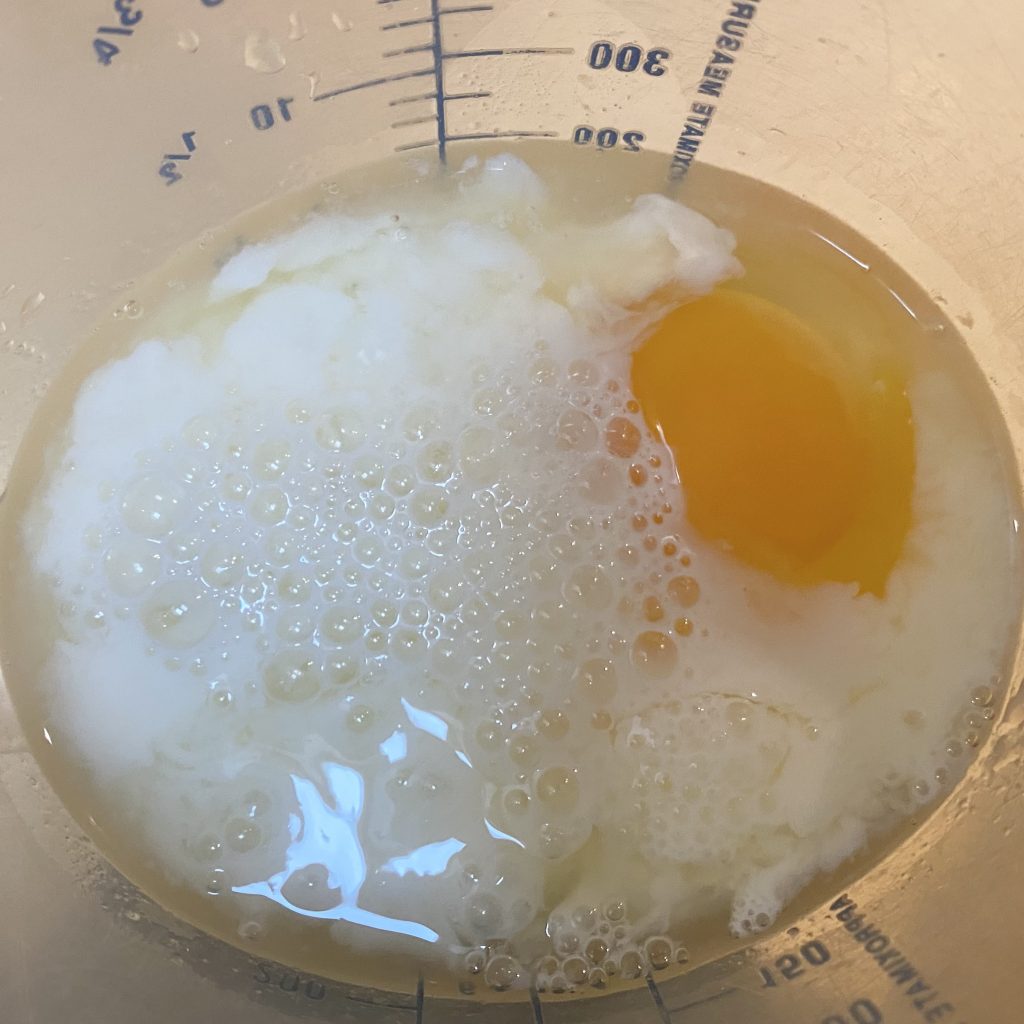
Meanwhile, whisk together the egg, milk and lemon juice in a jug. When the flour mixture is ready, keep the mixer running while you gradually pour in the wet ingredients.
Once you have added all of the liquid, turn the mixer up to high speed and beat for 30-60 seconds, until the cake batter looks smooth and silky.
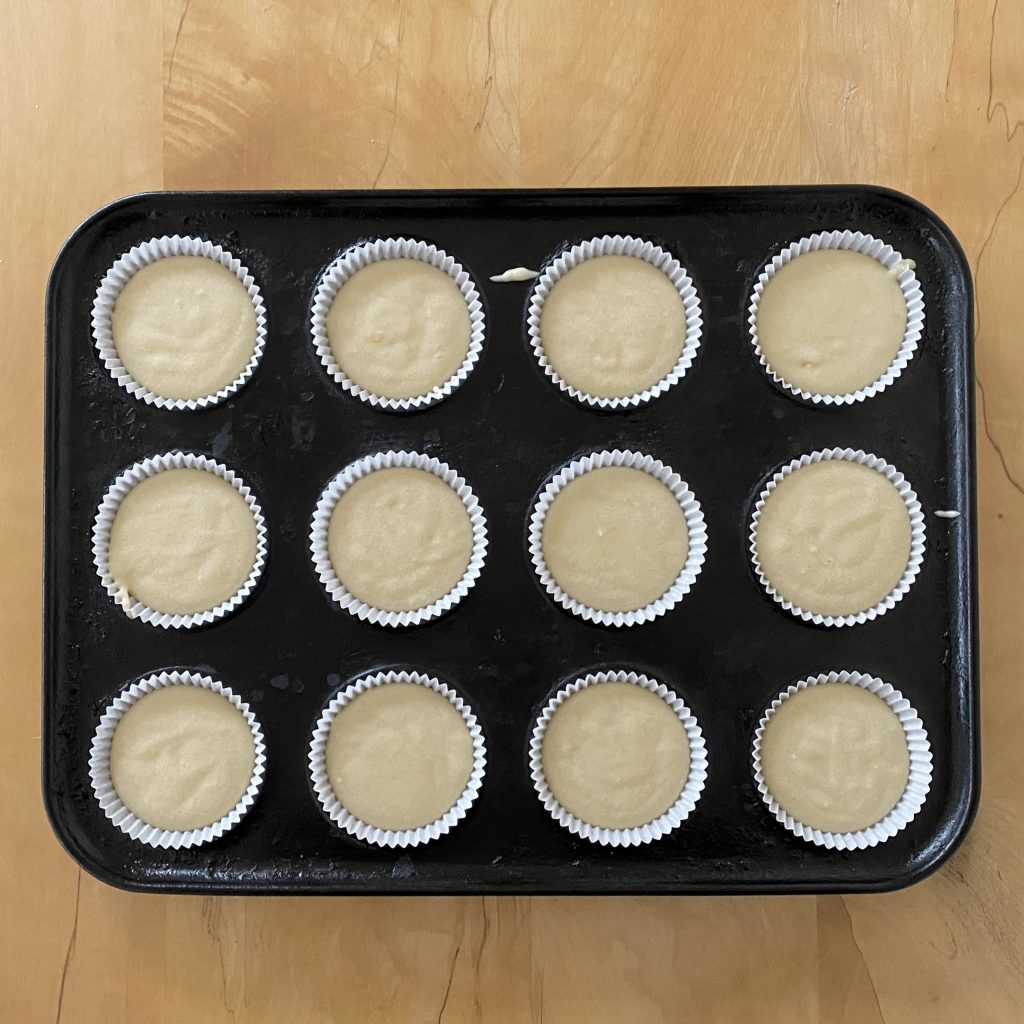
Divide the batter evenly between the 12 fairy cake cases (they should be about 3/4 full). The batter is quite liquid, so I find it easiest to transfer it to a jug first and then pour it into the cases. Once the cases are filled, bake the cakes in the preheated oven for 20-25 minutes, until they are golden brown and spring back when pressed gently.
As always, I like to remove the cakes from the tin as soon as they come out of the oven, to prevent the bottoms from becoming greasy. Transfer them to a wire rack and allow them to cool completely before assembling the cakes.
Making the Elderflower Ermine Buttercream
Ermine buttercream, also known as ‘boiled milk’ or ‘flour’ buttercream, is a little kooky, but it’s silky-smooth and significantly less sweet than a typical American buttercream, so I’m a big fan of it. It works particularly well in this recipe, because it can take the extra sweetness of the elderflower cordial. To make ermine buttercream, you make a sweet, flour-based ‘pudding’, which you then whisk into softened butter to make the buttercream. I know it sounds weird, but it works!
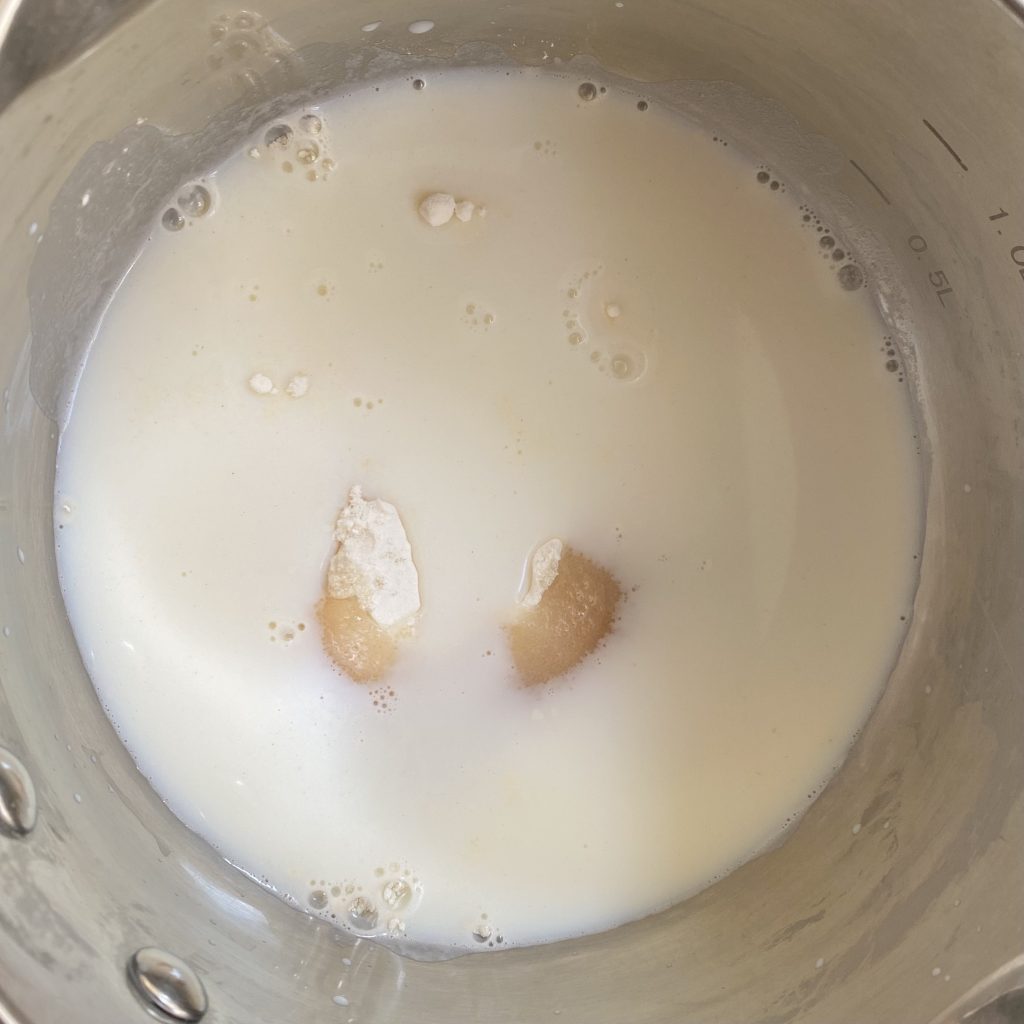
You need to make the pudding element ahead of time, so that it has enough time to cool down to room temperature (though this doesn’t take very long- only about 30-40 minutes). I usually make it before I make the fairy cakes themselves, then finish the buttercream off once it’s time to assemble them. To make it, place the flour, caster sugar, salt and milk into a small saucepan over medium heat.
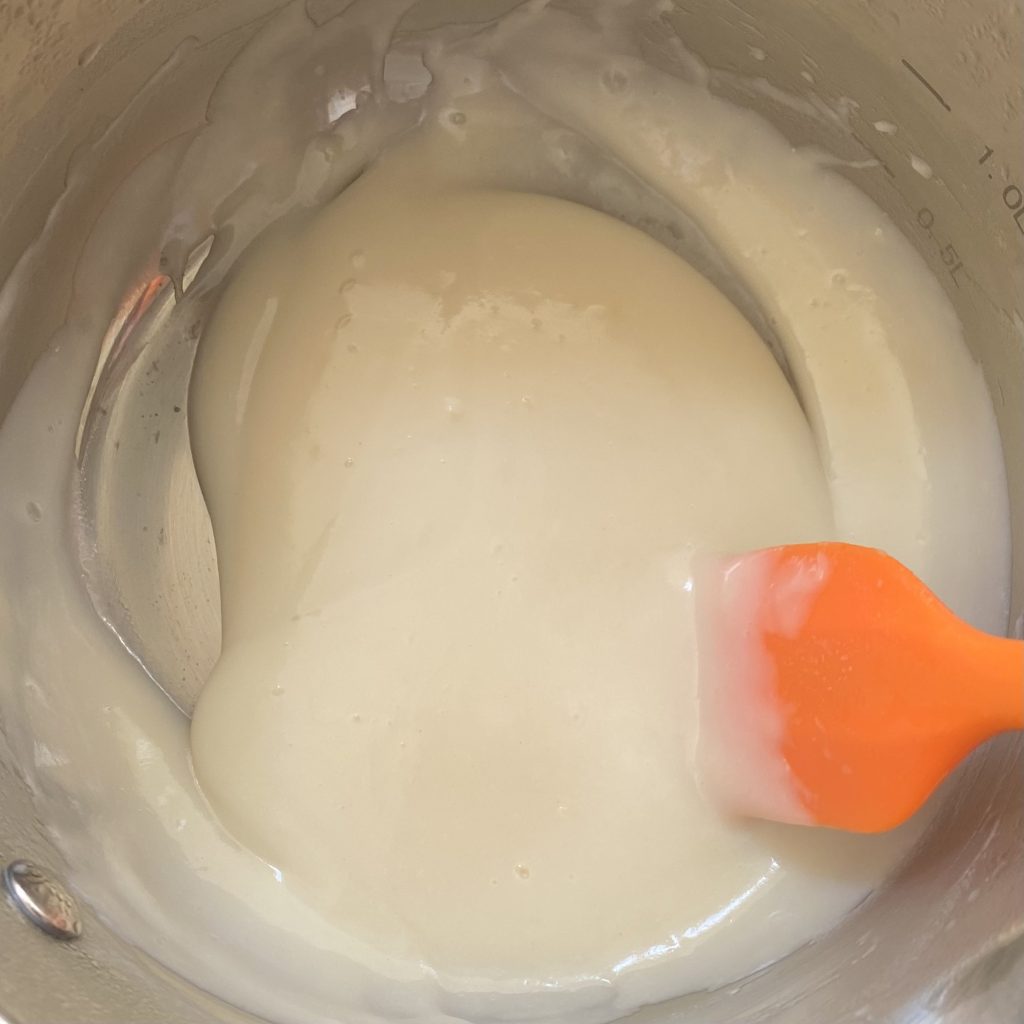
Whisk the ingredients together as they melt, then keep whisking until the mixture turns into a thick pudding. Please don’t be alarmed by the fact that it looks vaguely grey at this stage- I promise that the finished icing won’t be grey!

Transfer the pudding to a shallow dish and cover the surface directly with cling film, then leave it to cool down to room temperature before proceeding with the buttercream.
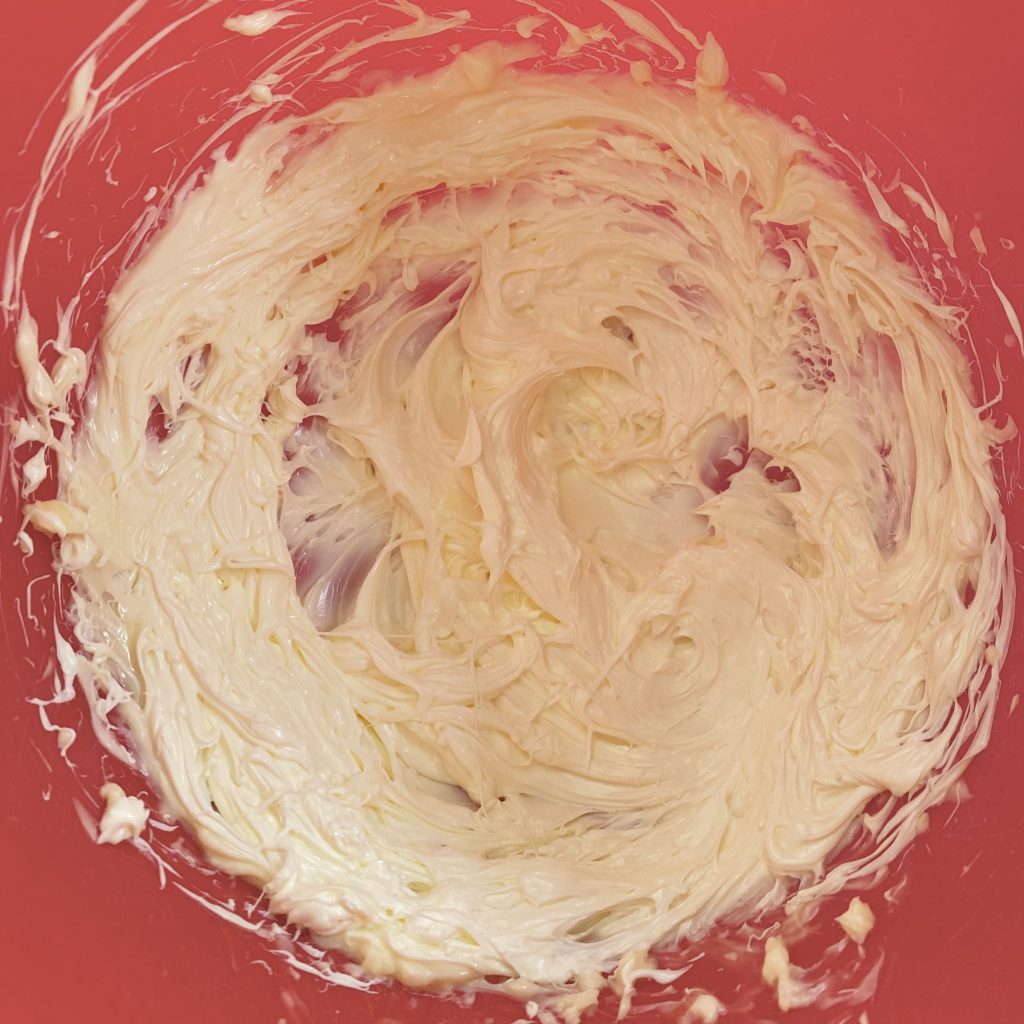
Once the pudding has cooled to room temperature and you’re ready to assemble the cupcakes, you can finish making the buttercream. Place the softened butter into a large bowl and beat with an electric mixer until soft, fluffy and significantly paler in colour.
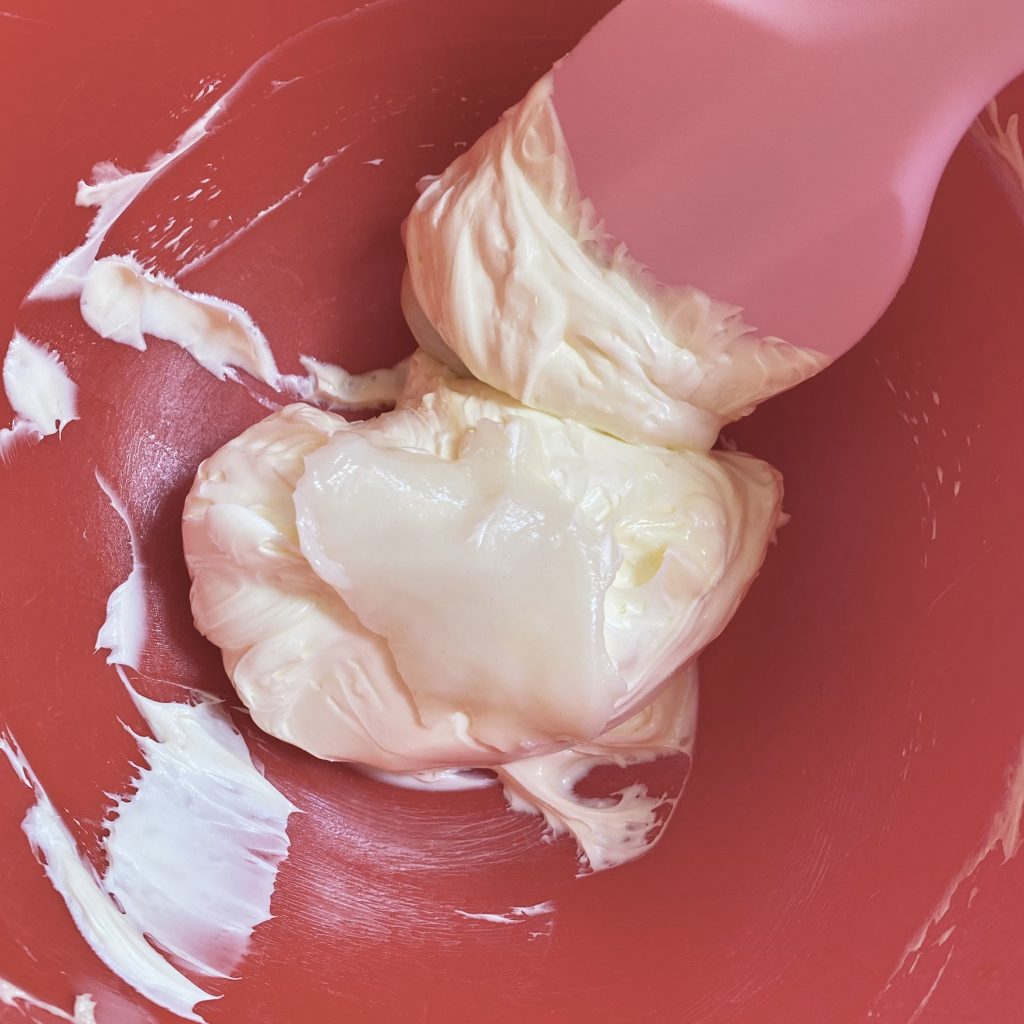
Add a spoonful of the cooled pudding mixture and whisk until completely combined.
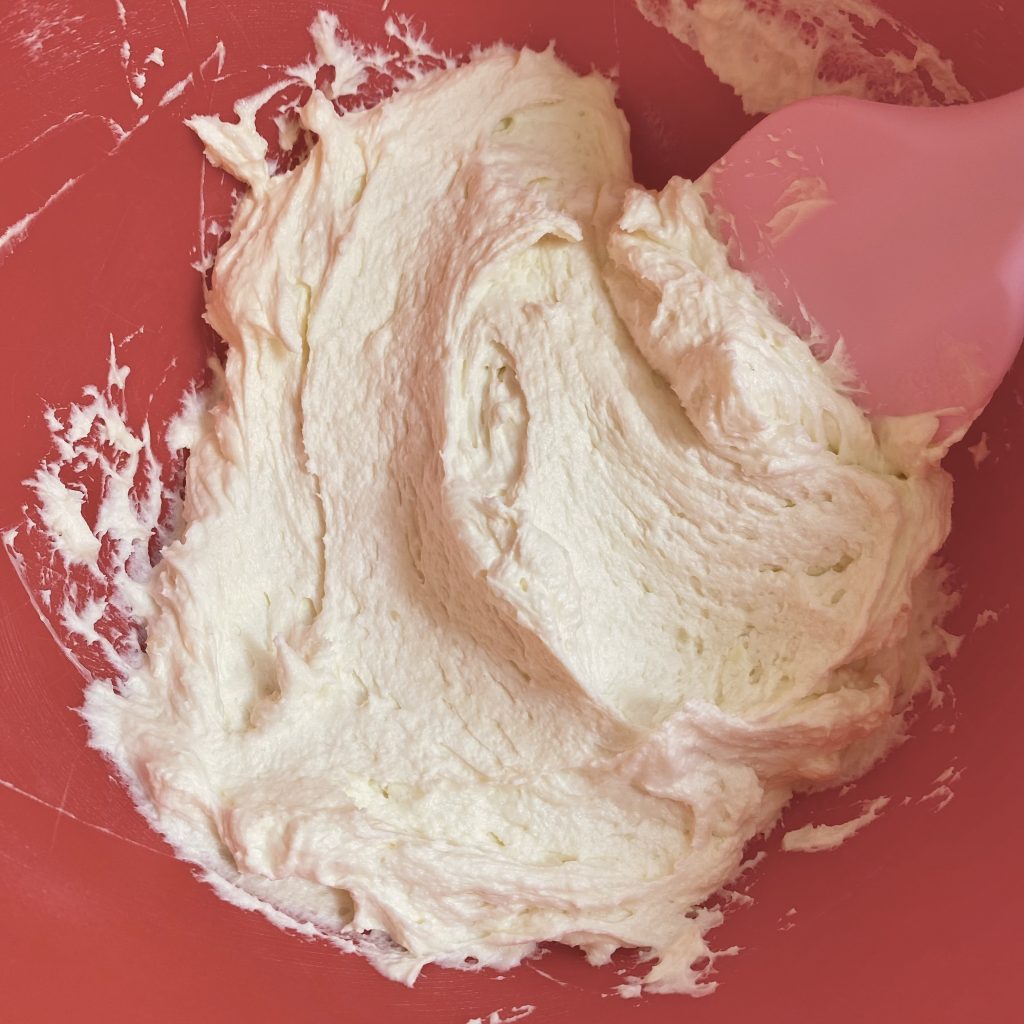
Keep going, adding a spoonful of pudding at a time and whisking between each addition, until all of the pudding has been incorporated.
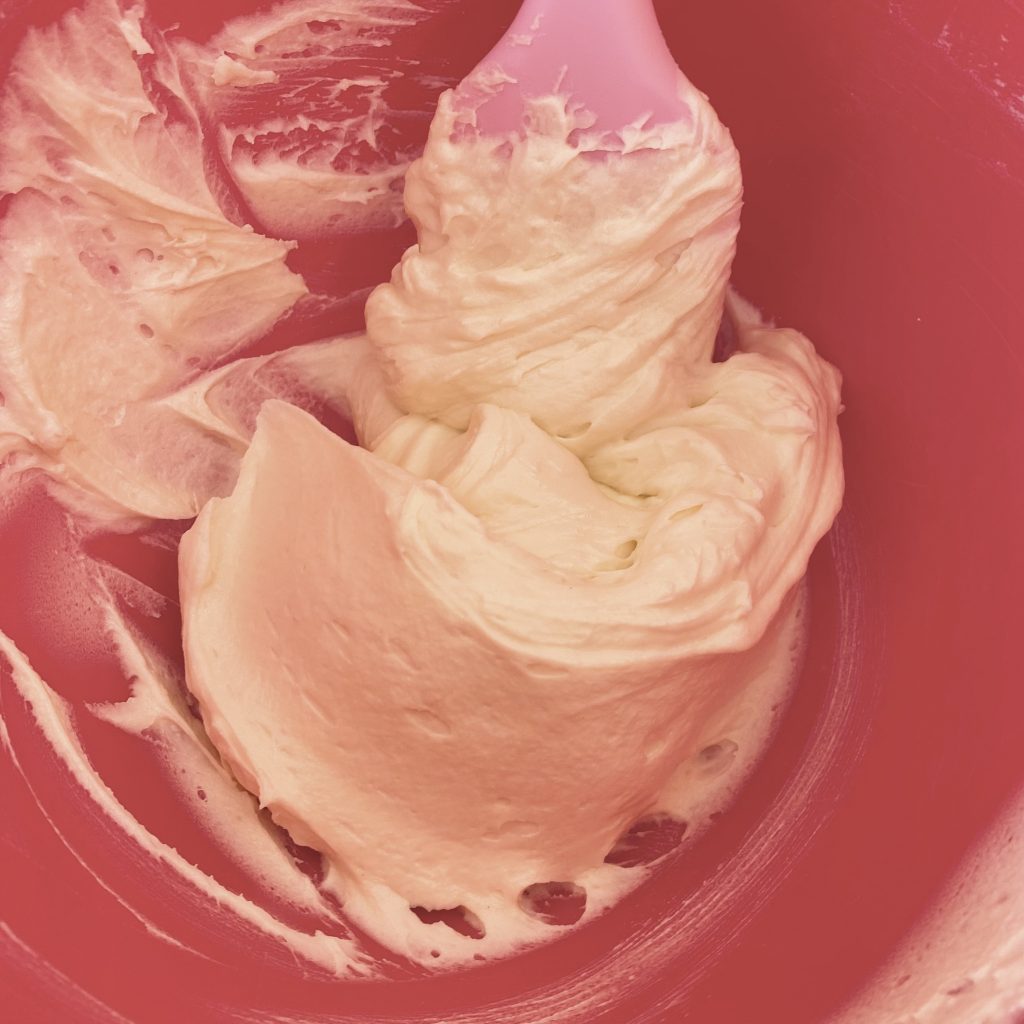
At this point, you can add the elderflower cordial. Mix again to incorporate the cordial fully and then your elderflower ermine icing is ready to go!
Assembling the Butterfly Cakes
Once your cupcakes are cool, your buttercream is ready and your curd is nice and chilled, you can assemble your cupcakes!
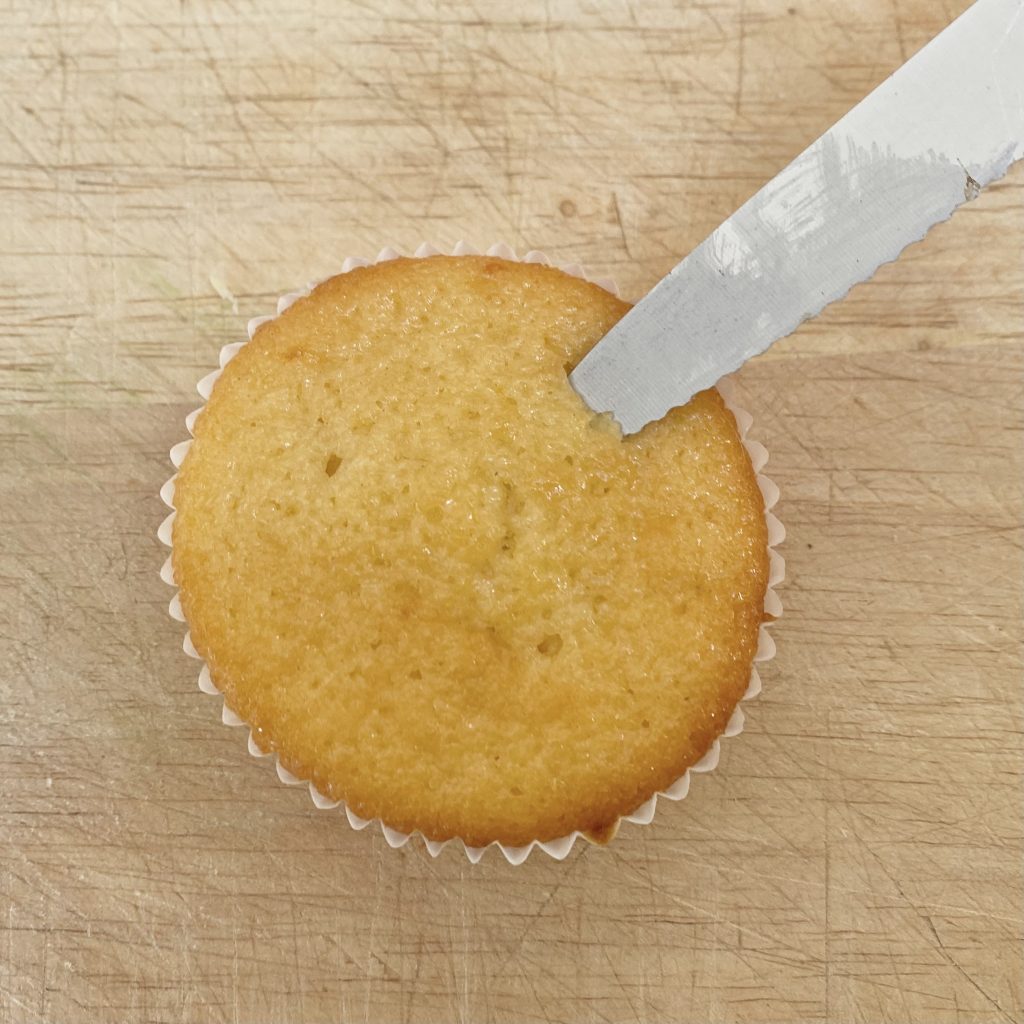
The first thing you need to do is cut out the cake for the wings. Use a small, sharp knife, at an angle, like in the photo.
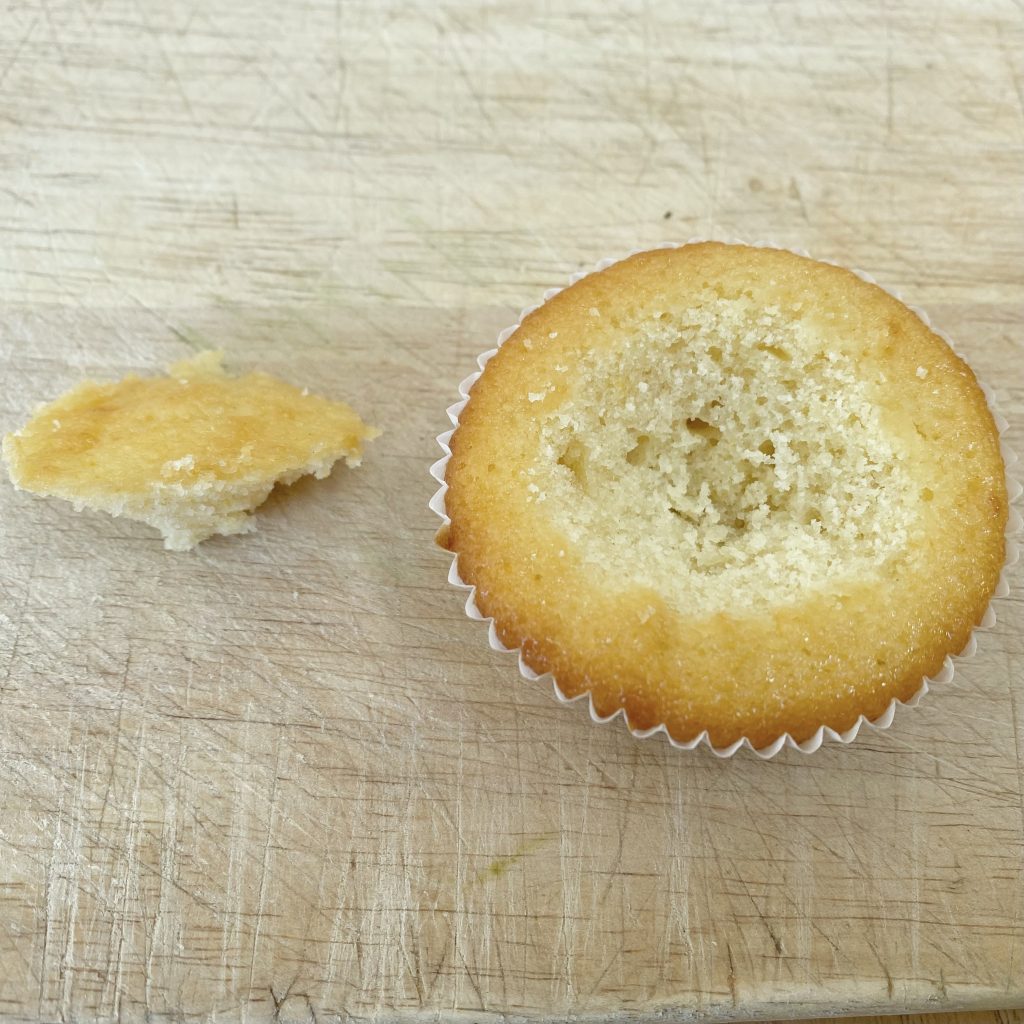
Carve a shallow cone shape from the centre of each cupcake, like this.
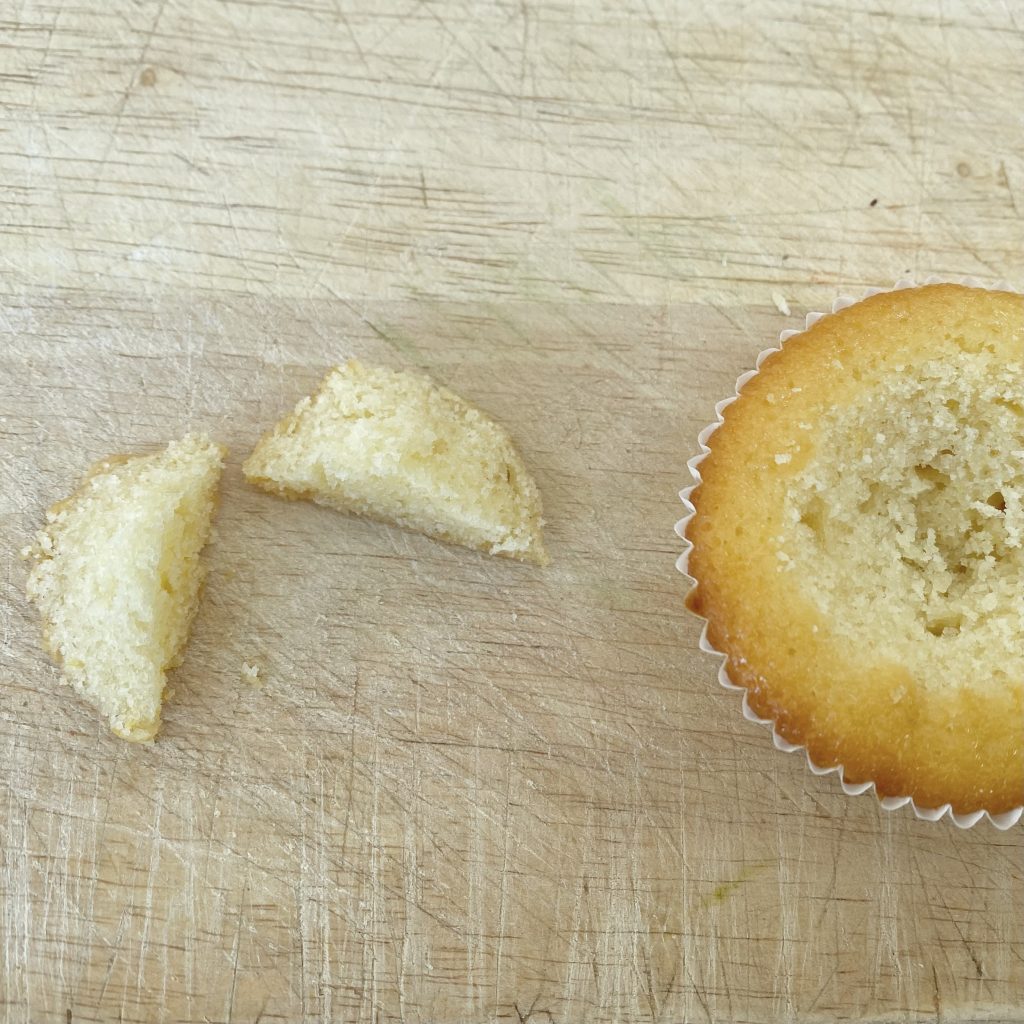
Cut each of the cone-shaped pieces of cake in half, leaving you with two little cake ‘wings’ per cake.
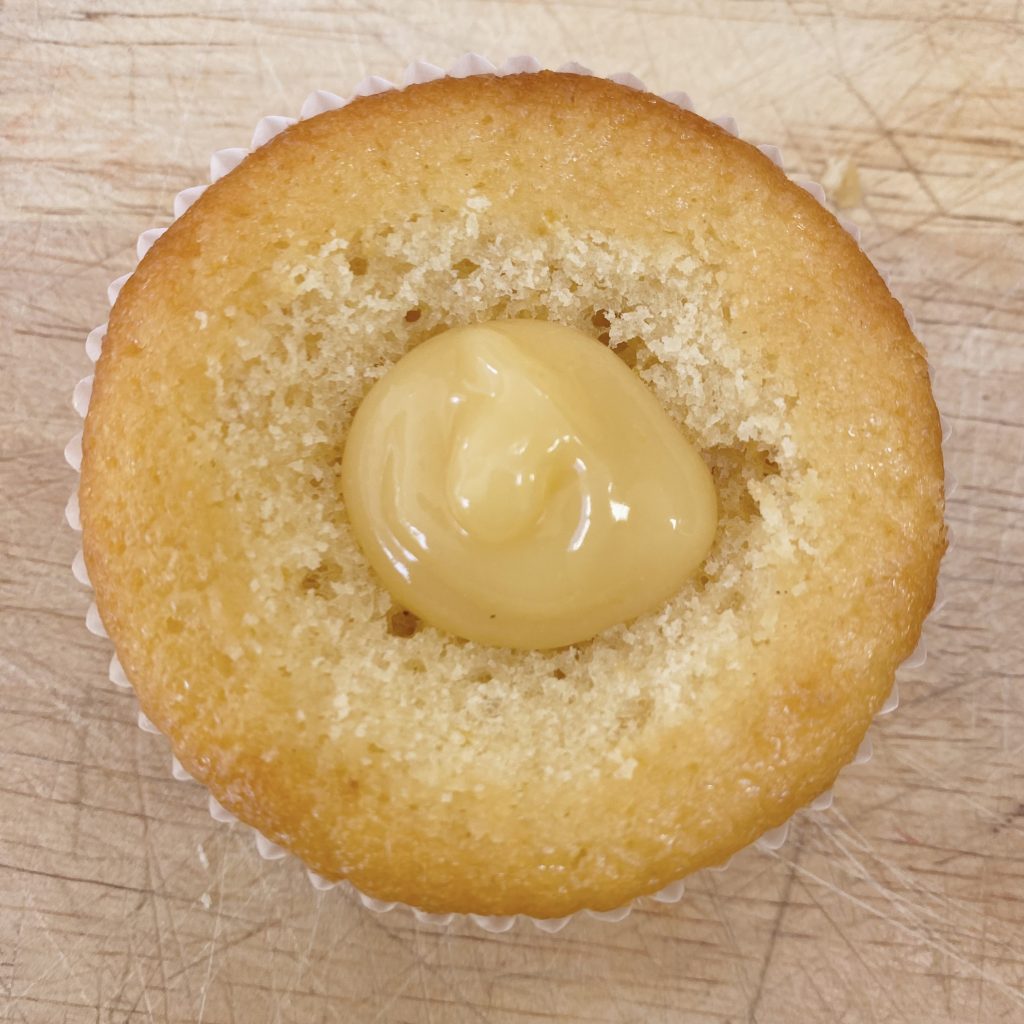
Next, add a generous amount of lemon & elderflower curd into the hollow of each of the cakes.
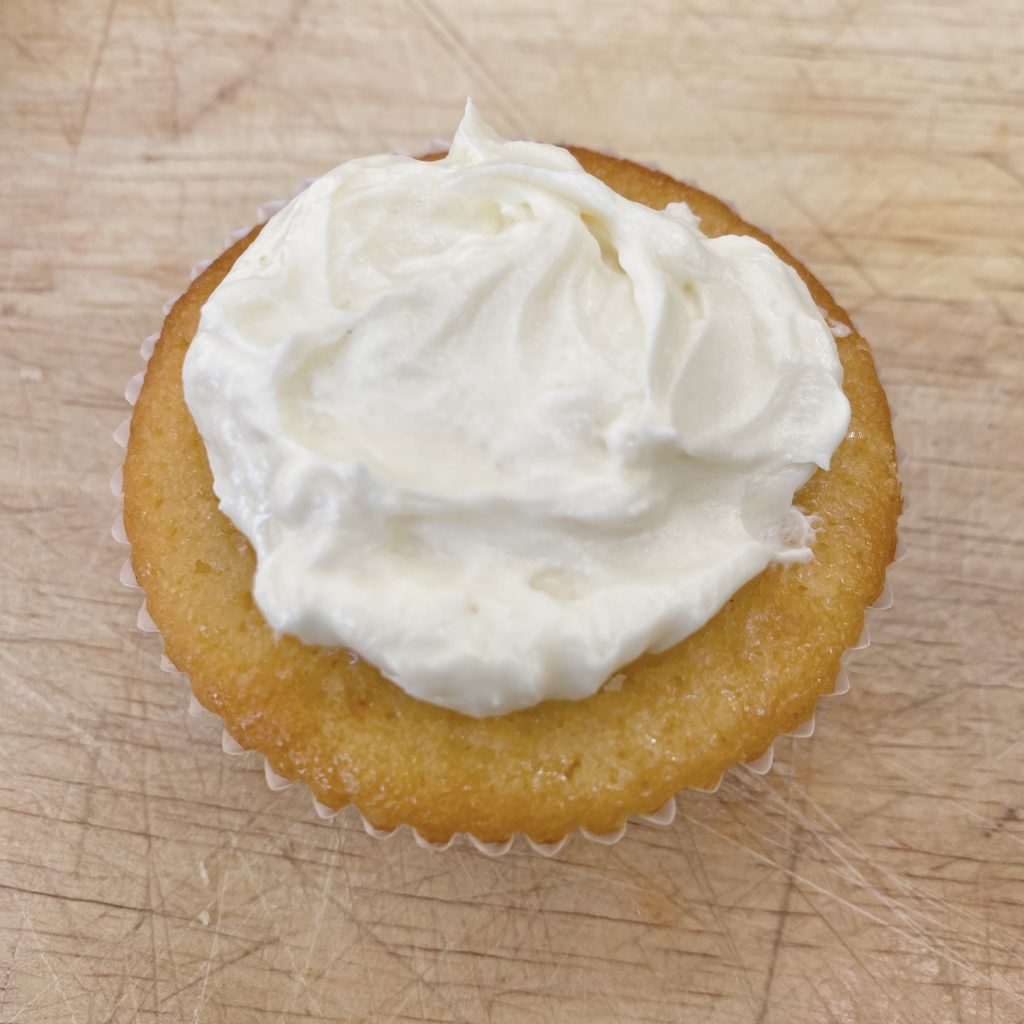
Add a big dollop of elderflower buttercream right on top of the curd and spread it out so that it completely conceals the hollow beneath, but doesn’t go right to the edges of the cake itself. You can absolutely pipe the buttercream, if you prefer (I would recommend using a large, round nozzle for this), but I kept things simple by just using a spoon.
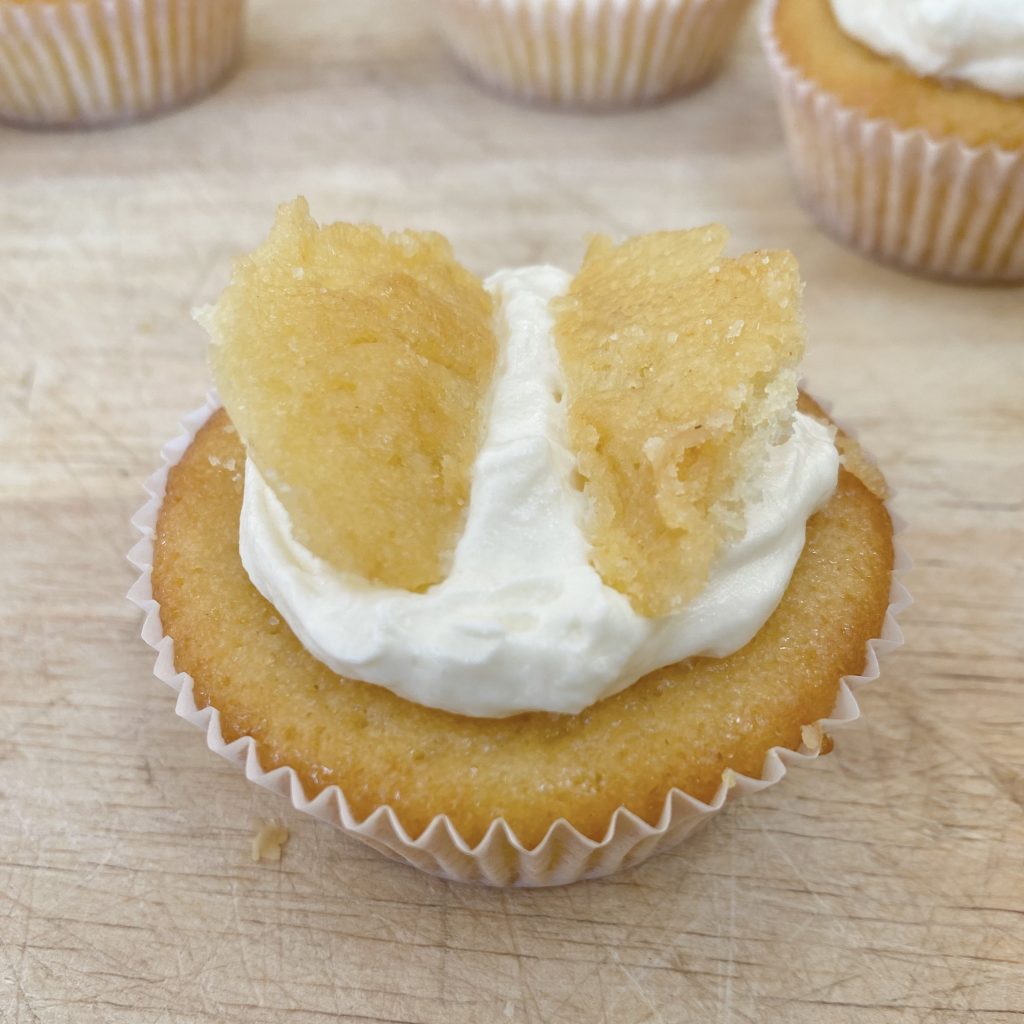
Once all of the cakes are filled, you can add the ‘wings’ back on. Push them into the buttercream at a slight angle, so the straight edges are aligned in the centre, making your fairy cakes look like little butterflies.
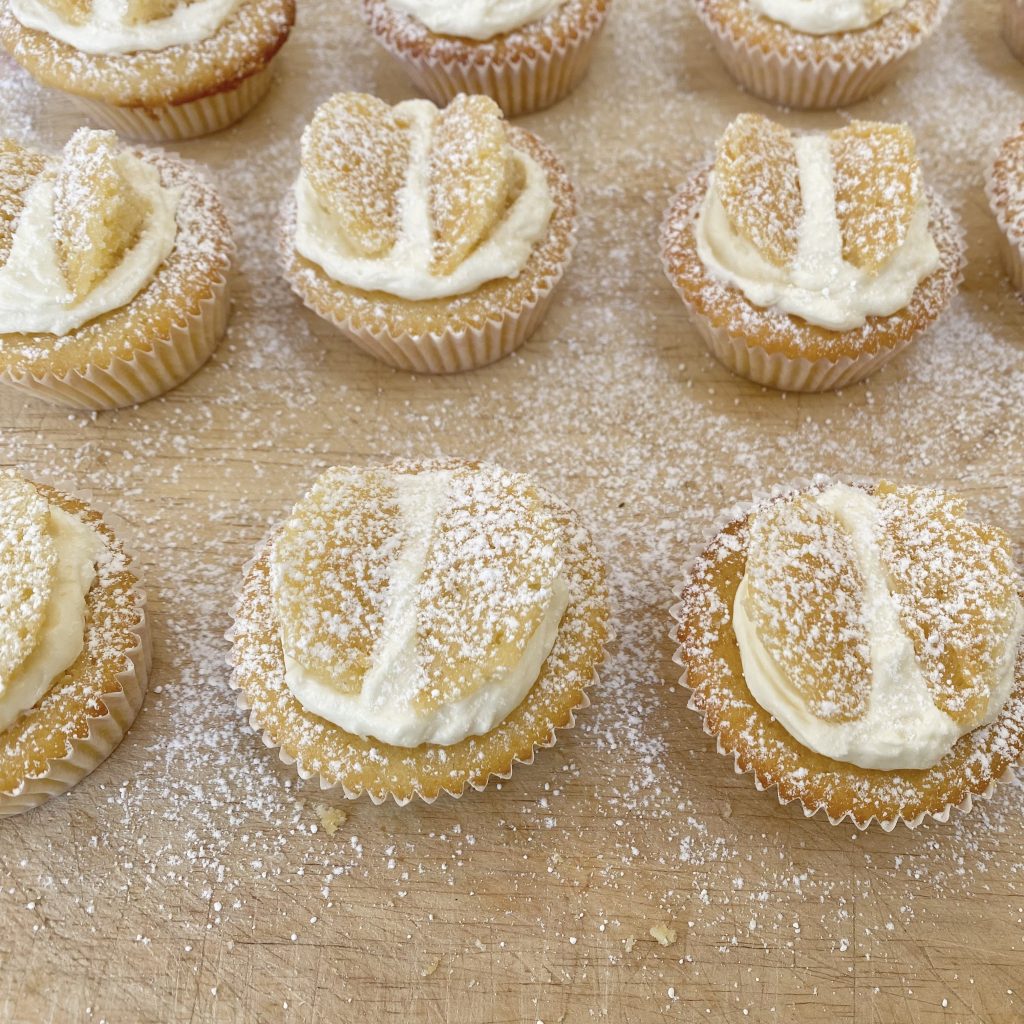
To finish off the butterfly cakes, I like to dust them with a little bit of icing sugar. After that final flourish, they’re done! As with most cakes, they’re best served on the day they’re made, but they will keep for 2-3 days in an airtight container in the fridge.
Lemon & Elderflower Butterfly Cakes Recipe
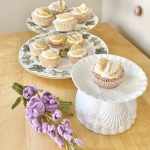
Lemon & Elderflower Butterfly Cakes
Ingredients
For the lemon & elderflower curd:
- 1 egg
- 75 g caster sugar
- 1 lemon, zest and juice.
- 55 g unsalted butter, diced.
- 1 tbsp elderflower cordial
For the lemon fairy cakes:
- 125 g plain flour
- 125 g caster sugar
- 1/2 tbsp baking powder
- Pinch of salt
- 1 lemon, zest and juice.
- 50 g Stork (see Note 1).
- 1 egg
- 90 ml milk
For the elderflower ermine buttercream:
- 10 g plain flour
- 30 g caster sugar
- Pinch of salt
- 90 ml milk
- 75 g unsalted butter, softened
- 2 tsp elderflower cordial (or to taste).
To serve:
- Icing sugar, for dusting.
Instructions
Make the lemon & elderflower curd:
- Place the egg, sugar, lemon zest and juice into a small saucepan. Whisk together until fully combined, then add the butter.
- Place the saucepan over medium-low heat and stir constantly with a spatula as the butter melts. Once melted, keep stirring over the heat until the curd becomes thick and smooth.
- Pass the curd through a heatproof, fine mesh sieve into a small bowl, to remove any bits of egg. Add the elderflower cordial to the strained curd and stir through to incorporate.
- Cover the surface of the curd directly with clingfilm, then place into the fridge to chill and thicken up even more (about an hour, but, if you prefer, you can make the curd in advance and store it like this in the fridge for 4-5 days).
Make the pudding base for the elderflower ermine buttercream:
- Place the flour, caster sugar, salt and milk into a small saucepan. Whisk over medium heat until the sugar has melted and the mixture has thickened into a smooth pudding.
- Pour the pudding into a shallow dish and cover the surface directly with clingfilm. Set aside to cool to room temperature while you make the lemon cakes.
Make the lemon fairy cakes:
- Preheat the oven to 180°C (conventional oven). Line a 12-hole fairy cake tray with fairy cake cases and set aside (see Note 2).
- Place the flour, sugar, baking powder, salt and lemon zest into the bowl of a freestanding mixer, fitted with the paddle attachment. Mix briefly on low speed to combine.
- Add the Stork and mix again, until the mixture resembles fine breadcrumbs.
- In a jug, whisk together the egg, milk and lemon juice. With the mixer running, add the wet ingredients to the flour mixture in a slow, steady stream.
- Once all of the milk mixture has been added, turn the speed up to high and beat for 30-60 seconds, until a smooth batter has formed.
- Divide the mixture between the prepared fairy cake cases, then bake in the preheated oven for 20-25 minutes, until the cakes are golden brown and spring back when their surfaces are pressed gently.
- As soon as the cakes come out of the oven, transfer them to a wire rack to cool completely (this will prevent the cases from becoming greasy) before assembling.
Finish preparing the elderflower ermine buttercream:
- Place the softened butter into a large bowl and beat, using a handheld electric mixer, until soft, smooth and significantly paler in colour.
- Add a spoonful of the cooled pudding base to the whipped butter and whisk well to incorporate.
- Continue adding the pudding to the butter, a spoonful at a time, whisking between each addition, until all of the pudding has been added.
- Add the elderflower cordial and whisk again to finish off the buttercream.
Assemble the butterfly cakes:
- Use a small, sharp knife to carve out a shallow, cone shape from the top of each fairy cake. Cut each of these cone shapes in half to make two 'wings'.
- Place a generous amount of lemon & elderflower curd in the cut-out hollow of each cake, then top with a dollop of elderflower buttercream. Use the back of a spoon to spread the buttercream out, so that it completely conceals the hollow beneath.
- For each cake, press the two 'wings' into the buttercream at an angle, so that their straight sides line up in the centre, like a butterfly.
- Dust the cakes with a small amount of sifted icing sugar and serve. The cakes are best served the day they are made, but will keep in an airtight container in the fridge, for 2-3 days, if needed.
Notes
- As always, I like to use Stork in my cakes because I think it makes for a lighter, fluffier cake. If you cannot find Stork, or would prefer not to use it, use an equal amount of softened unsalted butter.
- Fairy cake trays/cases are not the same as cupcake trays/cases. They are much flatter, so take a lot less batter and bake more quickly. You can find fairy cake cases at most supermarkets.

